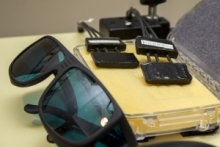Faculty Design Tool to Monitor Blood Flow in Stroke Patients

Using a University of Pennsylvania-designed device to noninvasively and continuously monitor cerebral blood flow (CBF) in acute stroke patients, Penn Medicine and Arts and Sciences researchers are now learning how head of bed (HOB) positioning affects blood flow reaching the brain.
Most patients admitted to the hospital with an acute stroke are kept flat for at least 24 hours in an effort to increase CBF in vulnerable brain regions surrounding the damaged tissue. Researchers report in the journal Stroke that, while flat HOB did increase CBF in the damaged hemisphere in most stroke patients, about one quarter of the patients had a paradoxical response and showed the highest CBF with their head at an elevated angle.
The Penn team, led by James M. Skinner Professor of Science Arjun Yodh of Physics and Astronomy, has been developing a new optical device that permits noninvasive and continuous monitoring of CBF at the patient’s bedside. The key technology is a probe placed on the surface of the head that measures the fluctuations of near-infrared light that has travelled through the skull and into the brain, then back out to the tissue surface. These fluctuations are caused by moving red blood cells in tissue, and have been shown to accurately track CBF in underlying brain tissue.
The study illustrates the potential of using advanced technology to make individualized treatment decisions in real time. Patent US#8,082,015 has been granted to the University of Pennsylvania for the optical CBF technology. Besides application to neurological disorders, it is being tested in a number of other clinical populations in whom CBF changes are relevant.
The research was funded by a Bioengineering Research Partnership grant from the National Institutes of Health's National Institute of Neurological Disorders and Stroke as well as an NINDS Center Core in Neuroimaging, the Eunice Kennedy Shriver National Institute of Child Health and Human Development, and National Institute of Biomedical Imaging and Bioengineering, along with the Sao Paolo Research Foundation and Fundacio Cellex.





